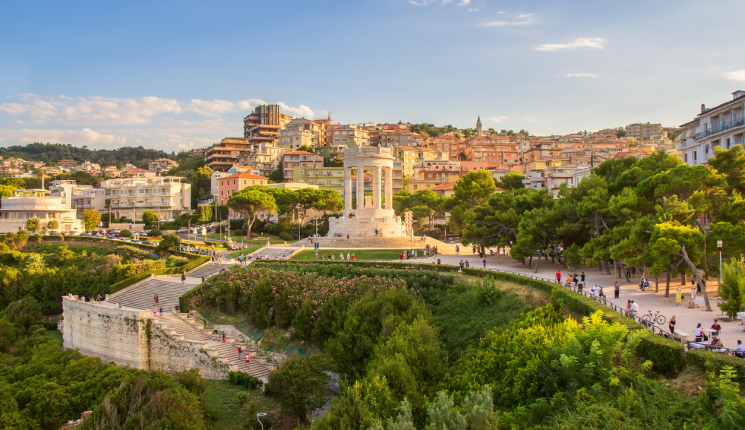
Ancona
Ancona is a charming port city located on the eastern coast of Italy. It is the capital of the Marche region and is known for its rich history, stunning architecture, and beautiful coastline. Visitors can explore the city's many historical landmarks, such as the Cathedral of San Ciriaco, the Arch of Trajan, and the Palazzo del Governo, which houses the city's art museum.
Ferry tickets and routes to Ancona
Get updated by booktickets on ferry ticket prices and schedules for your trip to Ancona. There are ferry routes from various cities in Greece to the port of Ancona in Italy. Ferries operate throughout the year, with more frequent schedules during the summer.
Below are the details for routes from Patras and Igoumenitsa to Ancona:
- Ferries routes and tickets from Patras to Ancona: There are at least 1-2 ferries from Patras to Ancona every day all year round. The duration of the trip from Patras to Ancona ranges from 19 to 22 hours. The ticket prices start from €105.
- Ferries routes and tickets from Igoumenitsa to Ancona: Ferries from Igoumenitsa to Ancona operate year-round, with 1-2 daily ferry routes. During the summer, the routes are more frequent. The duration of the trip from Igoumenitsa to Ancona is approximately 15-17 hours.
It is recommended to book your ferry tickets to Ancona in advance, especially during the summer season.
Please click on the "BOOK NOW" button and use the booking form provided by booktickets to view the most recent prices and exact schedules for each date, including all the ships serving the routes to and from Ancona.
History of Ancona
Ancona owes its origin to Greek merchants from Syracuse who founded the city in the 4th century BC. The Greeks observed the convenient location of the future settlement, as the city is situated on a promontory shaped like a bent elbow or knee, which protects the largest natural harbor in the central Adriatic. In Greek, "ankon" means "knee."
By the late 2nd century BC, during the reign of Emperor Trajan, Ancona came under the control of the Roman Empire. Later, the port fell under the rule of the Byzantine Empire. In 774, the city passed to the Papal States.
In the late 12th century, Ancona became a free city and a republic. During this period, there were conflicts with the Holy Roman Empire and Venice. In 1173, the city was besieged by the troops of Emperor Frederick I Barbarossa.
During the Renaissance, following the fall of Constantinople and the discovery of America, the importance of coastal cities in the Adriatic Gulf began to decline.
During the Napoleonic Wars, the city was occupied by the troops of Napoleon Bonaparte, who declared the province a Republic and annexed it to Rome. In 1860, Ancona was annexed to the Kingdom of Italy. Today, Ancona is an important industrial and transportation center. Due to its rich history, it boasts numerous landmarks and points of interest.
Beaches in Ancona
- Passeto is a picturesque beach in the city, located in a scenic area of the town. It stretches for about one kilometer beneath a tall white-gray cliff. The sea is clear with rocky seabed. To reach the beach, you can use stairs starting from the War Memorial or use an elevator.
- Palombina is a classic sandy beach, which is a favorite holiday destination for many tourists and locals of Ancona. It stretches for about four kilometers, and the sea is shallow, making the beach suitable for children. To get to Palombina beach, you can use any suburban bus heading north from the central railway station.
- Portonovo is a beach with smooth white pebbles and fine golden sand, located in a cove at the foot of Mount Conero, in one of the most beautiful sections of the Adriatic coast. To reach Portonovo, you can use a bus.
Sights in Ancona
Ancona offers a range of historical and cultural sights that are worth exploring.
- One of the most iconic landmarks in the city is the Cathedral of San Ciriaco, located on a hill overlooking the port. This stunning Romanesque church dates back to the 11th century and features a beautiful marble façade and intricate frescoes.
- Another must-see attraction is the Arch of Trajan, a Roman triumphal arch that dates back to the 2nd century AD and stands as a symbol of the city's ancient past. Visitors can also explore the impressive Museo Archeologico Nazionale delle Marche, which showcases a range of archaeological artifacts and artworks from the region.
- Ancona is also home to several beautiful parks and gardens, such as the Parco del Cardeto and the Giardini di Piazza Roma, which offer a peaceful escape from the city's bustling streets. Whether you're interested in history, art, or nature, Ancona has plenty to offer visitors.
